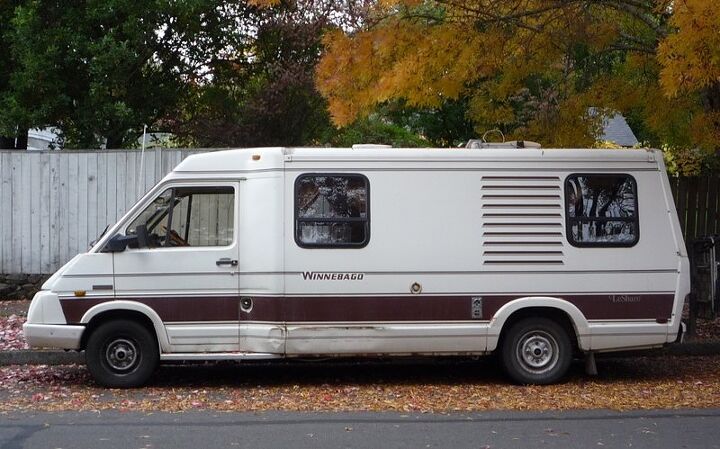Curbside Classic: 1985 Winnebago 23mpg LeSharo Turbo Diesel RV

Like cars, or even more so, the quest to find fuel efficiency in RVs has come and gone with the price of fuel. In the early eighties, when gas was around $4.00 in today’s dollars, the RV business crashed and desperately looked for a radical solution. One could say that the Winnebago LeSharo was the equivalent of the 1985 Cadillac DeVille: downsized to the extreme. Winnebago desperately searched for the solution, and found it in…France. LeSharo: the LeCar of RVs.
The LeSharo was one of those great ideas that ran aground on the realities of its Renault engine and transmission. Renault had just recently introduced its new FWD diesel Traffic van. Winnebago bit, and another Franco-American tie-up was created, and Renault shipped cabs complete with front drive train, and a rear axle to Winnebago, where the low and light (5,000 lb) 1983 LeSharo was born. The economy (20-23 mpg) was enticing; the Renault engine and transmission less so.
It may have worked ok in a small van delivering baguettes in Paris, but the 57 hp 2.1 L diesel four was overwhelmed by American standards. In 1984, a 75 hp turbocharged version was quickly rushed into service. But numerous and severe problems with both the engine and the four-speed manual transaxle necessitated abandoning it. By 1986, the diesel was out, and Renault’s 2.2 liter gas four (as used in their US cars) and a three-speed automatic transmission were in. mileage was more like 16-19 mpg. With the proper knowledgeable attention, they can be made to last reasonably well.
This combination was relatively more reliable, but lacked the diesel’s ultimate efficiency potential. The one I found here has the turbo-diesel stickers on the back, but since many were re-powered, its hard to say for sure. On the other hand, Eugene is the final destination of many old orphan diesels, so my guess it’s in the hands of a hard-core LeSharo TD fan. For those LeSharo lovers that are sick of the Renault issues, there is an outfit that does a regular business transplanting Chrysler 3.3 V6 minivan drive trains into these.
The LeSharo petered out in 1992, but was reincarnated in 1994 as the Rialta, now using a complete VW Eurovan front cab and drive train. The early versions used the 2.5 liter five, so it wasn’t exactly brimming with power either. Eventually, the VR6 engine was the definitive version. It appears to have gone out of production some time in the last few years, as Sprinter-based conversions and RVs offer real stand-up headroom and diesel economy.

More by Paul Niedermeyer
Latest Car Reviews
Read moreLatest Product Reviews
Read moreRecent Comments
- Jalop1991 Way to bury the lead. "Toyota to offer two EVs in the states"!
- Jalop1991 I'm sorry, Dave. I'm afraid I can't do that.
- Jalop1991 We need a game of track/lease/used/new.
- Ravenuer This....by far, my most favorite Cadillac, ever.
- Jkross22 Their bet to just buy an existing platform from GM rather than build it from the ground up seems like a smart move. Building an infrastructure for EVs at this point doesn't seem like a wise choice. Perhaps they'll slow walk the development hoping that the tides change over the next 5 years. They'll probably need a longer time horizon than that.





































Comments
Join the conversation
One of the problems is the cost of storing any RV or motor home. In my area this is not a small expense. If you live in an unincorporated area, this is no problem. But for those of us that live in 'Cities' it can be very expensive and very inconvenient.
The VW based Rialta and the pop top camper that replaced the Westfalias went out of production at the end of 2003 with the VW Eurovan when VW introduced a new generation of transporter and didn't bother to sell it in the US. As a side issue VW moved away from Westfalia conversions after Daimler bought them in 1999.